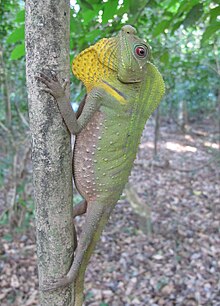Lyriocephalus
Эта статья требует дополнительных цитат для проверки . ( ноябрь 2019 г. ) |
| Lyriocephalus | |
|---|---|

| |
| Scientific classification | |
| Domain: | Eukaryota |
| Kingdom: | Animalia |
| Phylum: | Chordata |
| Class: | Reptilia |
| Order: | Squamata |
| Suborder: | Iguania |
| Family: | Agamidae |
| Genus: | Lyriocephalus Merrem, 1820 |
| Species: | L. scutatus
|
| Binomial name | |
| Lyriocephalus scutatus | |

| |
Lryiocephalus является родом ящерицы в семействе Агамид , с единственным видом Lryiocephalus scutatus . Это самый большой эндемичный для Шри -Ланки [ 1 ] и живет в густых лесах влажных зон. [ 3 ] It is also called the hump-nosed lizard, hump snout lizard or the Гордость Сингальский язык, он известен как «Badlimates, чтобы быть Canssadge -
Среда обитания и распределение
[ редактировать ]Большая ящерица агамид, широко распространенная во влажной низине и в середине голени Шри -Ланки, от 25 метров до высоты 1650 м.

Описание
[ редактировать ]Тело сжимается в боковом направлении. Пара маленьких шипов, присутствующих в затылке. Dorso-Nuchal Crest разработан. Шкалы лба Keed. Отчетливая костная арка или горб появляется на голове взрослых, давая ей свое название. Tympanum отсутствует. V-образный гулярный мешок присутствует. Большие, килевые шкалы гуляра можно увидеть. Хвост короткий и сжатый с тупым наконечником. Спинка светло -зеленый, желтый горло. Остальная часть вентера - кремовая.
The males are bright green with a yellow throat pouch and neck sail. Although the females can also exhibit this colouration, normally they are brown, especially when a male is present. Juveniles are brown.[4]
Ecology and diet
[edit]Inhabits forests with high canopy and dense undergrowth, but it occasionally also enters home gardens. Active during the day, when it dwells low on trees as well as on the ground. It goes higher up on trees to sleep at night. The typical threat posture is open-mouth gape, revealing the bright red lining of the oral cavity. This species is also known to feign death when picked up. Its diet comprises essentially of earthworms and also arthropods, including termites, butterflies, and moths. It is also known to feed on young shoots and buds.
Reproduction
[edit]About 1–11 eggs with measuring 12–13 * 20–22mm per clutch are produced in the months of January, March, May, June, September, October, and December. Eggs are buried after laid in the soil, sometimes under bushes. Incubation period lasts 35 days.
Pictures
[edit]References
[edit]- ^ Jump up to: a b Wickramasinghe, L.J.M., Kannishka, S., Pushpamal, V., Vidanapathirana, D., Jayasekara, D., de Alwis Goonatilake, S., Sivaruban, A. & Gabadage, D. (2021). "Lyriocephalus scutatus". IUCN Red List of Threatened Species. 2021: e.T170409A123298967. Retrieved 13 November 2021.
{{cite journal}}: CS1 maint: multiple names: authors list (link) - ^ "Appendices | CITES". cites.org. Retrieved 14 January 2022.
- ^ [1], The Reptile Database
- ^ Reptile Care Database, ″Lyriocephalus scutatus – LINNAEUS, 1758″, accessed 11.18.2019.



